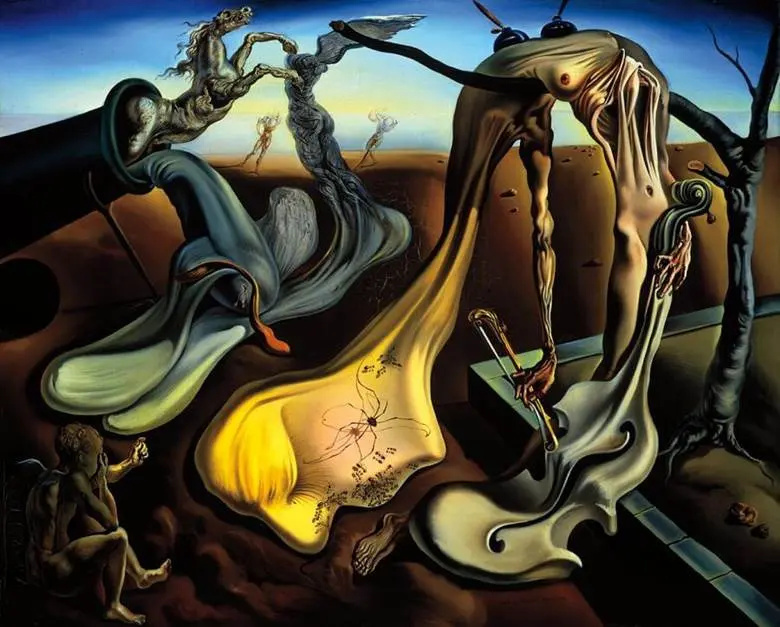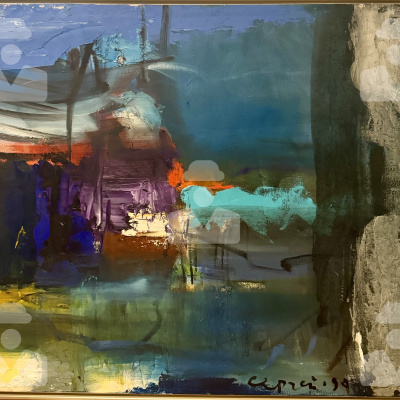In this article on Arthive, you will learn about 15 of the most famous surreal paintings by the Spanish artist Salvador Dali. Read the reports and reviews of the authors of Arthive.

Salvador Dali was a very famous surrealist and is one of the greatest painters to have ever been in the industry. He has accomplished great feats with his painting and continues to do so posthumously.
The Surrealist artist Salvador Dali was born in May of 1904; this artist is mainly known for his precise craftsmanship, technical skill, and bizarre use of composition. If you ever spot a painting by him, Dali and surrealism and his unique style clearly pops out and lets you know it’s his painting.
He has had quite a few successes throughout his career as a painter. If you are interested in his work and understanding Dali surrealism , this article will further help you learn the motive behind all of his paintings. Salvador Dali and surrealism go hand in hand. Further mentioned here are 15 of Salvador Dali’s surreal paintings along with what is portrayed in each of them, what it means, and the year it was created.
The Surrealist artist Salvador Dali was born in May of 1904; this artist is mainly known for his precise craftsmanship, technical skill, and bizarre use of composition. If you ever spot a painting by him, Dali and surrealism and his unique style clearly pops out and lets you know it’s his painting.
He has had quite a few successes throughout his career as a painter. If you are interested in his work and understanding Dali surrealism , this article will further help you learn the motive behind all of his paintings. Salvador Dali and surrealism go hand in hand. Further mentioned here are 15 of Salvador Dali’s surreal paintings along with what is portrayed in each of them, what it means, and the year it was created.
The Great Masturbator (1929)
This is one of the most famous Salvador Dalí's surrealist paintings, and this art mainly represents the artist’s fear of female sexuality and castration. Nevertheless, it also highlights the potential to attain sexual and spiritual liberation.The most famous element in this painting is the grasshopper, which depicts Dali’s fear of insects. Currently displayed in Museo Nacional Centro de Arte Reina Sofía, Madrid, this painting is still considered one of his most notable works.

The Great Masturbator (1929)
The Persistence of Memory (1931)
Another famous Salvador Dalí's surrealist artwork can be described as a 'hand-painted dream photograph.' With this painting, he applied quite a few methods of surrealism and wanted to tap into the non-rational mechanisms of his mind.This included imagination, dreams, and even the subconscious to create the unreal forms and shapes that form the painting. Since 1934, it has been a part of the Museum of Modern Art’s collection.

The Persistence of Memory (1931)
Swans reflecting elephants (1937)
This oil on canvas was one of the more easily recognizable surrealism paintings by Salvador Dali. Taking reference from Sigmund Freud’s studies, Dali would self-induce a state of paranoia, allowing his brain to create any unseen links between two objects.This is what he referred to as his ‘Paranoic -critical' period. This painting is a product of that. However, you will not see it anymore since it is a part of a private collection now.

Swans reflecting elephants (1937)
The Temptation of Saint Anthony (1946)
Known for his Surrealism art, Salvador Dali drew the naked man in this painting as Saint Anthony, who appears to be struggling with several temptations. One of these is portrayed in the form of a horse. However, all these temptations must be avoided by Saint Anthony, using the cross to ward off vision. You can find it in the Royal Museums of Fine Arts of Belgium at this point.
The Temptation of Saint Anthony (1946)
Young Virgin Auto-Sodomized by the Horns of Her Chastity (1954)
During the 1950s, most of Salvador Dali’s surrealism paintings featured rhinoceros horns. In this painting, the artist depicted a young virgin with her back faced to the viewer and two rhinoceros horns floating beneath.Since the horns usually comprise and threaten to sodomize the figure, this painting shows how she gets effectively sodomized by her constitution. This painting is located in the Playboy Mansion now.

Young Virgin Auto-Sodomized by the Horns of Her Chastity (1954)
The Disintegration of the Persistence of Memory (1954)
This was painted as a response to the previously mentioned Surrealism Salvador painting, The Persistence of Memory. This can be called a recreation of that painting, as there are many of the same elements.However, this painting marked how Dali lost his interest in surrealism and became intrigued by physics, mainly the quantum world. You can now find this painting in St. Peter, Florida, in the Salvador Dali Museum.

The Disintegration of the Persistence of Memory (1954)
Spider of the Evening (1940)
This was more of a violent continuation of The Persistence of Memory and famously included melting clocks. By this Surrealism art, Dali tried to show the omnipresence of time and how it masters the habits of a human being. It is said that the inspiration arises from a surreal interpretation of how the cheese melts in the sun.
Spider of the Evening (1940)
Galatea of the Spheres (1952)
This painting is the perfect example of how Salvador Dali mimicked the aesthetical structure of DNA. In this painting, he parodied the molecular structure of human beings.This mainly represents his newfound interest in science and theories relating to the disintegration of an atom

Galatea of the Spheres (1952)
Dream Caused by the Flight of a Bee around a Pomegranate a Second Before Awakening (1944)
More commonly known as the 'Dream Cause by the Flight of a Bee', the woman in this painting is said to be his wife, Gala. The pomegranate in this painting is a Christian symbol of resurrection and fertility, and the bee above that symbolizes the Virgin.The distant seascape is also a much-argued symbol by art enthusiasts and critics. You can now find this painting in the Thyssen-Bornemisza Museum, located in Madrid.

Dream Caused by the Flight of a Bee around a Pomegranate a Second Before Awakening (1944)
Christ of Saint John of the Cross (1951)
A drawing mainly inspired this painting of Dali. He was tripping on ecstasy, a common drug found with Dali, while he had this vision of Christ.It depicts Jesus Christ on the cross, with a dark sky as the background floating over water with fishermen and a boat. This is currently presented as the collection of Kelvin grove Art Gallery and Museum, Glasgow. This is the perfect example of Salvador Dali’s surrealism .

Christ of Saint John of the Cross (1951)
Soft Construction with Boiled Beans (Premonition of Civil War) (1936)
Salvador Dali created this piece to depict the horrors faced during the Spanish Civil Wars. However, the interesting fact about this painting is that it was painted only 6 months prior to the actual war. He later said that he was aware of a war beginning. Located in the Philadelphia Museum of Art, this is a must-visit if you are a fan of Dali’s work.
Soft Construction with Boiled Beans (Premonition of Civil War) (1936)
The Ghost of Vermeer of Delft Which Can Be Used As a Table (1934)
When compared to his other paintings, this was a rather small oil painting. It takes inspiration from 'The Art of Painting,' which was done by a seventeenth-century painter.It was Dali’s take on this self-portrait of Vermeer. This is one of Dali’s several compositions showcasing his huge admiration for Vermeer with his back to us. This painting is located with The Disintegration of the Persistence of Memory in the Salvador Dalí Museum in Florida.

The Ghost of Vermeer of Delft Which Can Be Used As a Table (1934)
The Burning Giraffe (1937)
First used by Dali in his 1930 film L’Age d’Or, which loosely translates to The Golden Age, the burning giraffe was again spotted in a painting called 'The Invention of Monsters.'This Salvador Dali surrealism artwork could be described as a masculine apocalyptic monster that was also warming to the effects and possibilities of war. He believed the only way humanity could be saved through psychoanalysis.

The Burning Giraffe (1937)
Metamorphosis of Narcissus (1937)
Dali was undoubtedly one of the biggest fans of Sigmund Freud’s work. During their meeting, he thought of bringing this painting along to discuss the psychoanalytical theory of Narcissism and the concept of paranoia. On seeing this painting, he was also permitted to sketch Freud himself.
Metamorphosis of Narcissus (1937)
The Elephants (1948)
Dali’s impression of elephants is usually portrayed with multi-jointed, long, and rather invisible legs of desires, carrying loads on their backs. These animals are used to represent the future and also as a symbol of strength. Most of Dali’s paintings show elephants carrying obelisks. These are considered to be a symbol of domination and power in Salvador Dalí's surrealism .
The Elephants (1948)
These are 15 of the most notable Dali surrealism
paintings, one of the greatest and most celebrated painters of today. Dali never suffered from any kind of financial crisis and was always appreciated by his viewers and critics for the work he had done. He has had an enormous role in bringing forward the Salvador Dali artistic movement and making it a household name.



















